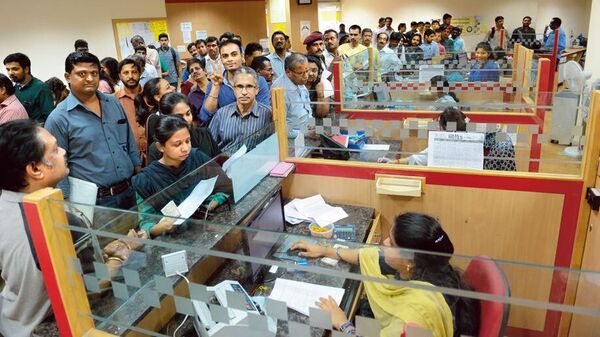On 10 March 2023, US-based Silicon Valley Bank (SVB) failed. It led to a trail of runs on other banks and distress and anguish among customers across geographies. It also highlighted the fragility of the banking system in the US and Europe. As Mervyn King, former governor of the Bank of England, has said: “Most banks are global in life, but national in death.”
SVB was known as a ‘frictionless’ bank. A WhatsApp forward, however, generated panic that led to the digital withdrawal of some $43 billion worth of deposits between 9am and 10am that fateful day. This equalled 25% of its total deposits. A darling of venture capital funds, private equity players and startups, the bank was built with over 40 years of sweat and toil, but took just 40 hours to collapse.
The fallout of that bank failure has been extensive. The market capitalization of American banks plunged by over $229 billion within a few days of SVB’s failure, as once-robust balance sheets of banks began to look fragile. Policymakers across geographies had to work overtime to calm financial markets and stave off a bigger meltdown. In the US, Treasury Secretary Janet Yellen announced special protection even for uninsured deposits held by depositors with failed banks, a move estimated to cost the US Federal Deposit Insurance Corp (FIDC) over $20 billion. The US Federal Reserve opened up a special liquidity window (in the midst of its policy tightening to arrest inflation) against the face value of securities. In Europe, the Swiss banking regulator and government together hatched a shotgun marriage of age-old rivals Credit Suisse and UBS to save the former.
In my last Mint op-ed on 23 February 2023, I had concluded: “Regulatory bodies must also dynamize their approach as they cannot afford to be reactive anymore. ‘Regulatory slumber’ should be consigned to history.” Let’s look at the scenario that prevailed at the time of the latest bank failures.
As per Federal Reserve data, as of 8 March, the gap in the value of assets and liabilities of US commercial banks stood at $2,137 billion. Mark-to-market losses of over $2 trillion were more than 40% of the capital of all banks. Paper losses become real when depositors rush to claim their money. Meanwhile, money market funds (MMFs) grow to the detriment of bank deposits when interest rates rise, as MMFs adjust their returns on investment faster. More than 50% of SVB’s long-dated securities were under water, with mark-to-market losses. Its capital ratios were adverse and its customer profile skewed in favour of bulk deposits. It was like an accident waiting to happen.
Tim Scott, a Republican leader on the US Senate Banking Committee during the first round of Congressional Committee hearings, said SVB was “rife with mismanagement” and that a “clear supervisory failure” contributed to its collapse. Regulators, he added, appeared to be “asleep at the wheel.”
As for Fed chairman Jerome Powell, when questioned on the SVB failure at his press conference of 17 March after a 25 basis points hike in the US policy rate, he looked embarrassed and said the Fed was “soul searching”. The delineated role of this central bank includes promoting financial-system stability and supervising institutions. SVB’s failure followed a rapid reversal of the Fed’s low-rate policy after a prolonged phase of ultra-low rates as part of America’s extra-loose fiscal and monetary policies implemented in response to covid, but financial liberalization after its Dodd-Frank legislation and a culture of bank bailouts were also notable aspects of the backdrop.
The financial-market brewery was heady. The explanation offered to the Congressional Committee by Fed vice-chair and head of bank supervision Michael Barr, that SVB’s deficiencies dated back to late 2021 and were impressed upon its management in November 2022, smacks of abdication of responsibility. The unelected in authority can’t escape accountability.
Like with other unfortunate events, the regulatory apparatus was reactive. We still don’t know if the crisis is over. In a digital ecosystem, with transactions taking place at the speed of data transmission and social media guiding behaviour, a ‘reactive’ approach cannot prevent disasters. Rather, regulators need to be ‘proactive’ and ‘co-active’.
Regulators should build bridges for real-time flows of hot information on fresh developments, including the use of technology for financial transactions and the behaviour of participants. Constant scanning of big data through advanced analytics, together with machine learning and artificial intelligence, should help model alternate scenarios and solution frames for authorities to intervene in time to avert disasters and minimize large-scale misdemeanours. In hindsight, had some of the measures taken after 10 March (like the US Fed’s securities-at-face-value window) been available earlier, SVB and others may well have been able to survive a run on their deposits.
The credibility of the regulatory craft resides in the efficacy of balancing liberalization with the safety of the financial system. And this often requires timely interventions.
G.N. Bajpai is former chairman of the Securities and Exchange Board of India and Life Insurance Corp of India, and an author.
Download The Mint News App to get Daily Market Updates.
More
Less
#proactive #regulation #fend #SVBlike #bank #failures
